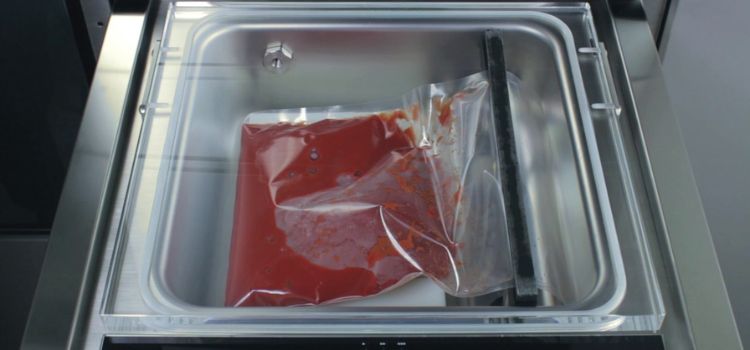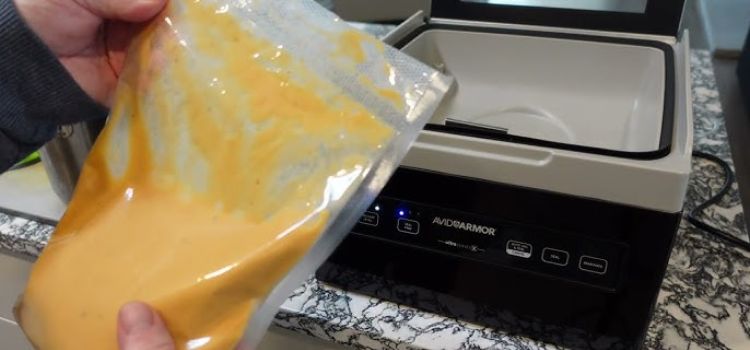As an Amazon Associate, I earn from qualifying purchases

Vacuum sealing is a fantastic method for preserving a wide range of foods, extending their shelf life, and maintaining freshness. While it’s commonly used for solids like meats and vegetables, vacuum sealing liquids presents a unique set of challenges. Whether you’re looking to store soups, sauces, or marinades, learning how to vacuum seal liquids without freezing them can save space and keep your ingredients fresh and ready to use.
The primary challenge with vacuum sealing liquids is preventing them from being sucked into the vacuum sealer, which can create a mess and potentially damage the machine. However, with the right techniques and equipment, you can successfully vacuum seal liquids without resorting to freezing them first. This article will guide you through the process, offering tips and highlighting common mistakes to avoid.
Challenges of Sealing Liquids
Vacuum sealing liquids is not as straightforward as sealing solids. The main issue arises from the nature of liquids—they flow and can easily be drawn into the vacuum sealer during the sealing process. This can lead to a messy overflow, compromising the seal and potentially damaging the machine. Additionally, achieving a proper seal with liquids can be tricky, as any residual moisture can prevent the bag from sealing correctly.
Understanding these challenges is the first step in mastering the art of vacuum sealing liquids. By addressing these issues head-on, you can ensure a clean, efficient sealing process that preserves your liquids without the need for freezing.
Necessary Equipment and Materials
To vacuum seal liquids effectively, you’ll need the right equipment and materials. Here’s what you’ll need:
- Vacuum Sealer Machine: Not all vacuum sealers are created equal when it comes to liquids. Look for models that offer a gentle suction setting or a pulse function, which allows you to control the suction manually. Some advanced models even have a liquid mode specifically designed for this purpose.
- Vacuum Seal Bags: Choose high-quality, BPA-free vacuum seal bags that are designed to withstand the pressure of sealing liquids. These bags should be durable and capable of forming a tight seal without tearing.
- Additional Tools and Accessories: Consider using a vacuum sealer with a drip tray to catch any overflow. A funnel can also be helpful for transferring liquids into the bags without spilling.
Step-by-Step Guide to Vacuum Sealing Liquids Without Freezing

Now that you have your equipment ready, let’s walk through the process of vacuum sealing liquids without freezing:
- Pre-chilling Liquids to Minimize Overflow: Before sealing, chill your liquids in the refrigerator. Cold liquids are less likely to foam or overflow during the sealing process, making it easier to achieve a clean seal.
- Using the Right Amount of Liquid per Bag: Avoid overfilling the bags. Leave enough space at the top to allow for sealing. A good rule of thumb is to fill the bag no more than two-thirds full.
- Setting Up the Vacuum Sealer for Liquid Sealing: If your vacuum sealer has a liquid or gentle mode, use it. Otherwise, use the pulse function to manually control the suction, stopping as soon as the air is removed but before the liquid reaches the seal.
- Sealing Techniques to Prevent Leaks: Once the air is removed, quickly seal the bag. Double-sealing the bag can provide extra security against leaks. Check the seal to ensure it’s airtight and free from any liquid residue.
Tips for Success
To ensure the best results when vacuum sealing liquids, consider these tips:
- Choosing Appropriate Sealing Settings: Use the lowest suction setting available to prevent liquids from being drawn into the machine. If your sealer has a pulse function, use it to control the process manually.
- Ensuring Bag Integrity and Avoiding Punctures: Handle the bags carefully to avoid punctures. Consider using a second bag for added protection, especially for liquids with sharp ingredients like herbs or spices.
- Storing Vacuum-Sealed Liquids Properly: Once sealed, store the bags upright in the refrigerator or pantry to prevent leaks. If you’re storing them in the freezer, lay them flat to save space and allow for even freezing.
Common Mistakes to Avoid
Even with the best intentions, mistakes can happen. Here are some common pitfalls to watch out for:
- Overfilling Bags, Leading to Sealing Failures: Overfilling is a common mistake that can prevent a proper seal. Always leave enough space at the top of the bag for sealing.
- Not Using the Correct Sealer Settings for Liquids: Using the wrong settings can lead to liquid being sucked into the machine. Always use the gentle or pulse setting when sealing liquids.
- Ignoring Pre-chilling and Preparation Steps: Skipping the pre-chilling step can result in messy overflows. Always chill your liquids before sealing to minimize this risk.
Conclusion
Vacuum sealing liquids without freezing is a valuable skill that can help you preserve soups, sauces, and other liquid-based foods efficiently. By following the steps outlined in this article and avoiding common mistakes, you can enjoy the benefits of vacuum sealing without the hassle of freezing. Whether you’re preparing meals in advance or storing homemade broths, vacuum sealing ensures that your liquids remain fresh and ready to use whenever you need them.
In summary, vacuum sealing liquids requires a bit of finesse and the right equipment, but the results are well worth the effort. With practice, you’ll be able to seal liquids cleanly and efficiently, saving space and preserving the quality of your ingredients. Happy sealing!
FAQ
How to keep liquid out of a vacuum sealer?
To prevent liquid from entering a vacuum sealer, pre-chill the liquid to reduce splashing, use a gentle or pulse mode to control suction, and leave ample space at the top of the bag. Additionally, consider using a vacuum sealer with a drip tray for added protection.
What is the best vacuum sealer for liquids?
The best vacuum sealer for liquids is one with a gentle suction or pulse function, allowing more control over the sealing process. Look for models with a liquid mode or built-in drip tray to handle potential overflow and prevent damage to the machine.
Does vacuum-sealed food need to be frozen?
Vacuum-sealed food doesn’t always need to be frozen, but freezing can further extend its shelf life. Vacuum sealing removes air, reducing spoilage and preserving freshness. For longer storage, especially for perishable items, freezing is recommended to maintain quality and prevent bacterial growth.
As an Amazon Associate, I earn from qualifying purchases